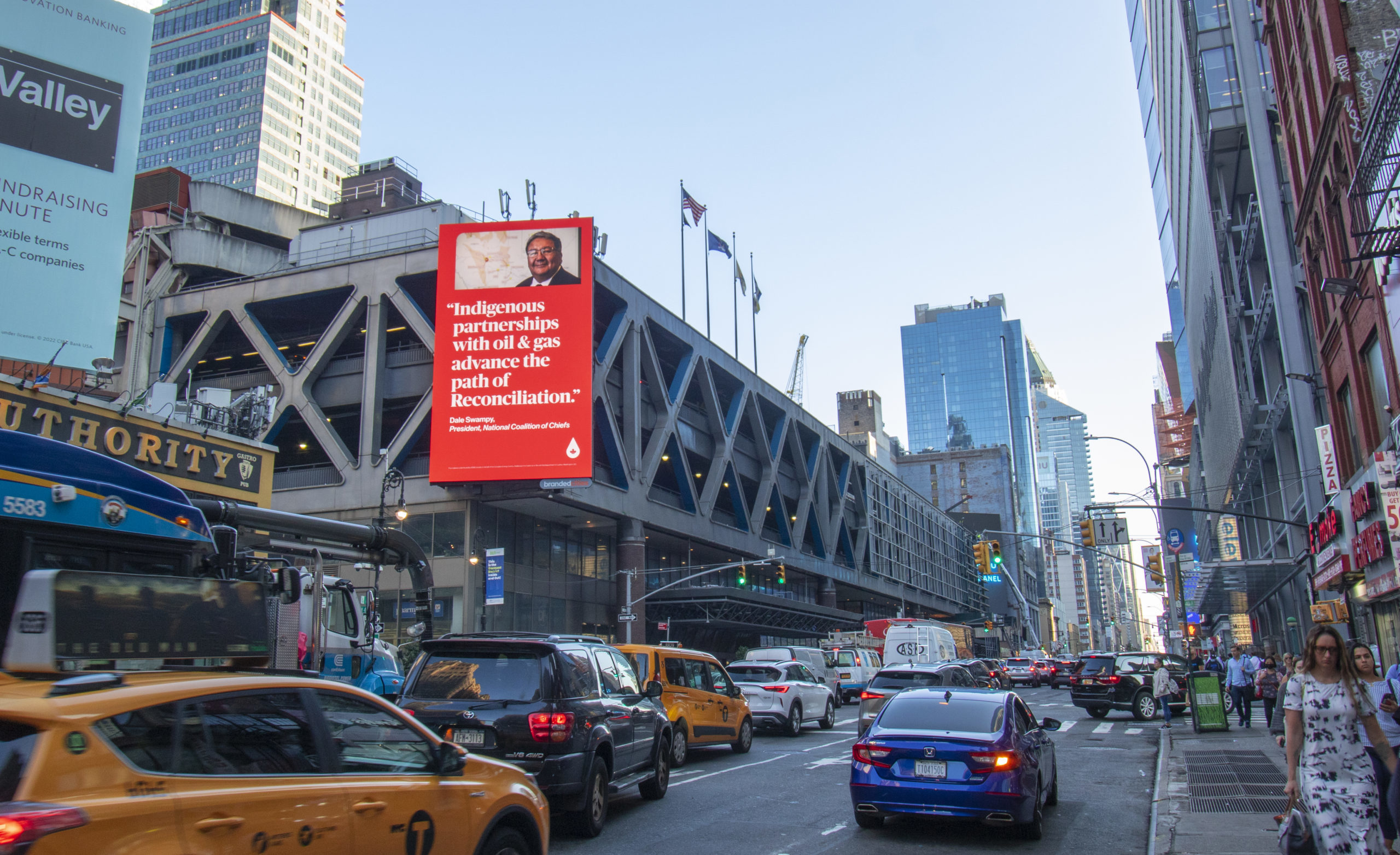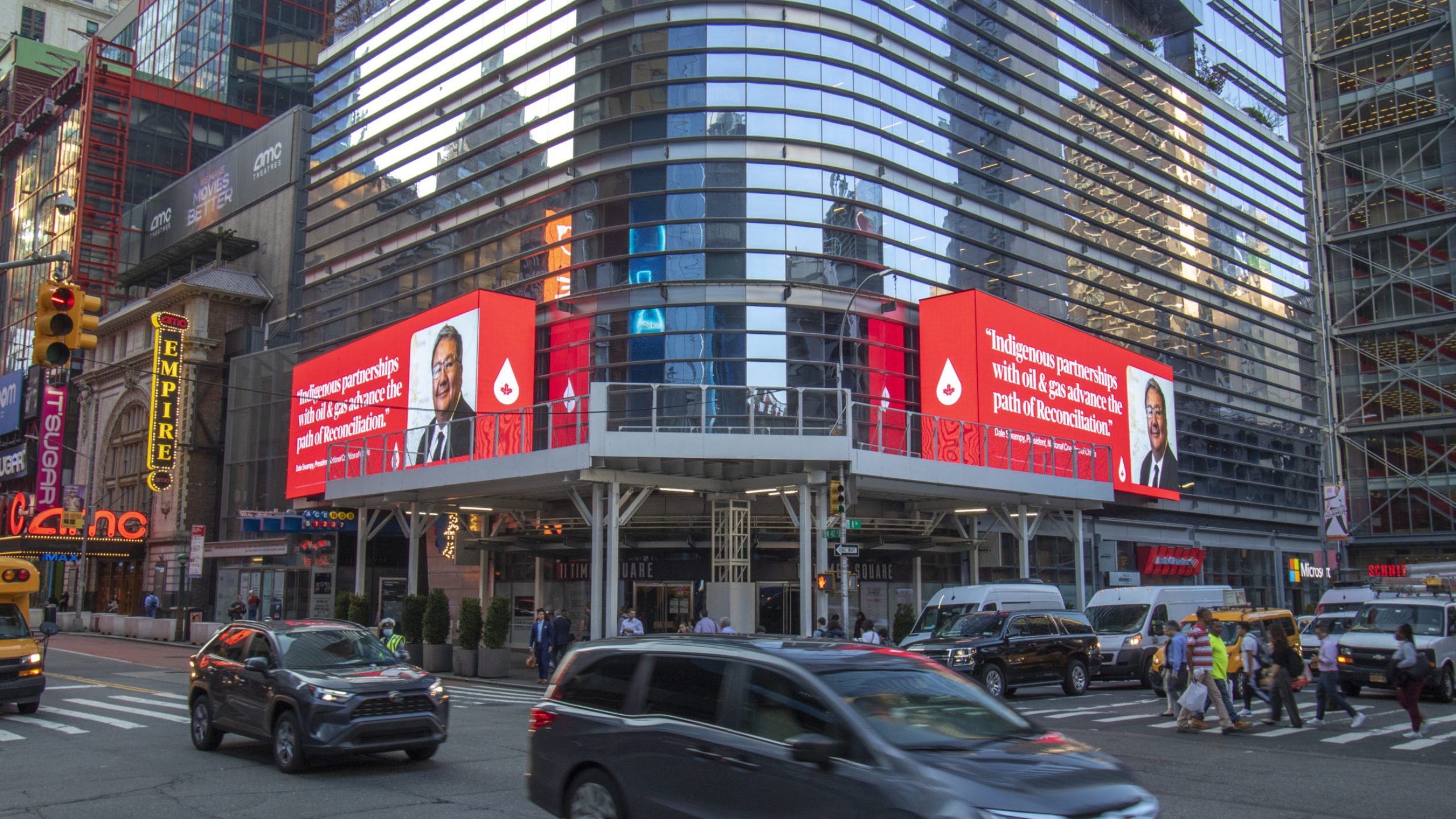A Canadian Indigenous leader is lending his voice to a Manhattan billboard campaign this month, hoping it will bring global understanding that the country’s energy industry is playing an important role in bettering the standard of living of many First Nations People in Canada.
“Partnerships with Canada’s energy sector offer an incredible opportunity to pull our next generation out of poverty,” said Dale Swampy, president of the National Coalition of Chiefs. “These partnerships advance the path of Reconciliation.”
Swampy, whose organization represents about 80 First Nations communities across Canada, hopes his message during New York’s Climate Week – one of the largest environment-focused events in the world – helps shine a light on the strong relationship many Indigenous communities have with Canada’s oil and gas and cleantech industries and the role economic and environmental partnerships have in the pursuit of Reconciliation.
“It’s important people also understand that the oil and gas industry is taking its commitment to tackle climate change seriously and that the inherent relationship our people have with the environment is helping projects to be developed more responsibly,” said Swampy.
Canada ranks number one among the world’s top oil reserve holders in all three areas of ESG –environmental protection, social progress and governance – according to international third-party assessments – and oil and gas employs more Indigenous people than any other industry in the country.
In fact, overall Indigenous representation in the oil and gas sector was more than 6% in 2019, according to Statistics Canada. For comparison, Indigenous peoples make up about 3.3% of Canada’s total workforce.
More and more First Nations communities and businesses are entering into equity partnerships and mutual benefit agreements on major pipeline and energy infrastructure projects. And Canada’s oil sands producers have spent $15 billion with Indigenous businesses since 2012, reaching a record $2.4 billion in 2019, according to the Canadian Association of Petroleum Producers.
“Yet unfortunately there are some coordinated groups who are preying on the desperation of some of our people to turn world opinion against Canada’s oil and gas industry,” said Swampy, a member of the Samson Cree Nation.
As a result, Indigenous communities lost out as governments have in the past bowed to extremist pressure and denied projects such as the Keystone XL and Northern Gateway pipelines, which would have brought hundreds of millions of dollars of economic growth to communities, he said.

The $65,000 campaign, sponsored by the Canadian Energy Centre (CEC), features Swampy and the simple message “Indigenous partnerships with oil and gas advance the path of Reconciliation.”
It will run Sept. 20 to 25 on three large outdoor electronic billboards in high traffic New York locations at Times Center, targeting Climate Week speakers, delegates and media.
CEC President and CEO Tom Olsen said Swampy has been an integral voice for Canadian First Nations involvement in beneficial equity partnerships.
“Dale has been a courageous voice for many years now on the important role First Nations leaders, businesses, and monitors can play in supporting stronger and more sustainable projects,” said Olsen.
“It’s time the world gained that understanding too.”
Quick facts:
- The oil and gas and mining sectors represent eight of the top 10 highest-paying occupations for Indigenous peoples for Canada, according to a report by the Macdonald Laurier Institute.
- Indigenous women earned three to four times more in wages from occupations in oil and gas than from median wages across all industries, according to the same report. In fact, oil and gas related occupations represent the top six highest paying occupations for Indigenous women in Canada, with pipeline transportation the highest.
- The Trans Mountain Expansion Project from Alberta to the British Columbia coast has signed mutual benefit agreements with 69 First Nations valued at over $600 million.
- The project has spent more than $3.2 billion with Indigenous-owned businesses ($1.3 billion in 2021 alone) and employed more than 2,100 Indigenous workers.
- Indigenous groups are seeking an ownership stake in Trans Mountain when the expansion is completed.
- Also in B.C., all 20 elected First Nations along the Coastal GasLink pipeline have signed project agreements. And 16 BC indigenous communities signed an historic agreement to become equity owners in the Coastal GasLink pipeline, once it’s up and running.
- Together the LNG Canada project and Coastal GasLink have spent more than $5.1 billion with Indigenous and local businesses.
- The Haisla Nation on B.C.’s north coast is approximately 50 per cent owner of Cedar LNG, a proposed $2.4-billion floating export terminal that if built will be the largest First Nations-owned infrastructure project in Canada.
- Ksi Lisims LNGis a $10-billion proposed new Canadian natural gas export project near the Alaska border on the B.C. north coast owned jointly by the Nisga’a Nation, Rockies LNG and Western LNG.
- The B.C.-based First Nations Major Projects Coalition and Miawpukek First Nation on Canada’s East Coast are working together on the first-ever Indigenous equity participation in an Atlantic offshore project, called LNG Newfoundland and Labrador.
- Canada receives number one rankings in all three areas of environmental protection, social progress and governance among the world’s top oil reserve holders – according to assessments of reputable third-party performance indexes including the Yale Environmental Performance Index, Social Progress Imperative Index, and World Bank Worldwide Governance Indicators.
More examples of equity partnerships with First Nations communities can be found at the campaign website at responsiblecanadianenergy.com
The unaltered reproduction of this content is free of charge with attribution to Canadian Energy Centre Ltd.
